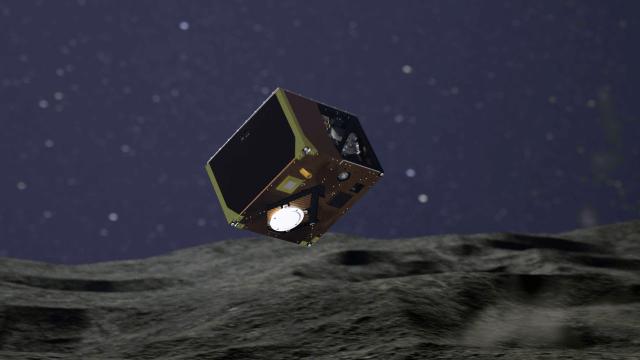Yesterday, a German-French probe called MASCOT began collecting valuable data from the surface of Ryugu, an asteroid located 300 million km from Earth. But it had to get cracking — the shoebox-sized probe was only expected to live for 16 hours.
The 10kg probe was designed and built by the German Aerospace Center, or Deutsches Zentrum für Luft-und Raumfahrt (DLR), in close cooperation with the French space agency CNES (Centre National d’Etudes Spatiales) and several other institutions. Measuring 29.5cm at its widest, the box-shaped probe is powered by a non-rechargeable battery that isn’t expected to last for more than 960 minutes.
And as of yesterday, this clock started ticking.
At 11:58AM AEST on Wednesday, Japan’s Hayabusa2 probe released the Mobile Asteroid Surface Scout, or MASCOT, which gently landed on the asteroid’s surface a few minutes later, according to DLR. During its 51m free fall, MASCOT descended no quicker than a walking pace. MASCOT now joins Japan’s two MINERVA-II rovers, which landed on Ryugu 10 days ago.
Hello #Earth, hello @haya2kun! I promised to send you some pictures of #Ryugu so here’s a shot I took during my descent. Can you spot my shadow? #AsteroidLanding pic.twitter.com/dmcilFl5ms
— MASCOT Lander (@MASCOT2018) October 3, 2018
“It could not have gone better,” said MASCOT project manager Tra-Mi Ho in a statement. “From the lander’s telemetry, we were able to see that it separated from the mothercraft, and made contact with the asteroid surface approximately 20 minutes later.”
During its free fall, the probe managed to capture 20 photographs of Ryugu, where which subsequently uploaded to the Hayabusa2 spacecraft for safekeeping.
Given its limited battery life, MASCOT was expected to expire shortly before 4:00AM AEST today. There’s been no news of its death yet, but it’s living on borrowed time.
Before this happens, however, the tiny probe will perform various measurements on Ryugu’s surface and transmit valuable data to Hayabusa2. To do so, MASCOT will use four instruments: A camera (MASCAM), a radiometer to measure electromagnetic radiation (MARA), an infrared microscope (MicrOmega), and a magnetometer to measure magnetic forces (MASMAG).
The probe will capture images at multiple wavelengths, analyse surface material, and record surface temperature, among other tasks.
After it performs its first set of planned measurements, the probe will hop to a second location and, fingers crossed, do it all over again before expiring; there’s only enough time for one hop. JAXA’s MINERVA-II1 and MINERVA-II2 probes will be able to make multiple leaps, hopping from location to location.
Data collected by MASCOT will help scientists study the Solar System’s “most primordial material directly on an asteroid,” as DLR planetary researcher Ralf Jaumann put it.
The next big milestone for the Hayabusa2 mission should come later this month. The spacecraft, after forming a crater on the asteroid’s surface with an explosive “impactor,” will descend to the crater and collect samples. Hayabusa2 and its precious cargo will then head back to Earth to complete this historic mission.
